#spoilers for Sumeru and Caribert
Explore tagged Tumblr posts
Text
Its always interesting to look at Paimon. She's either universally memed on, hated, or fans are neutral on her.
She's actually really interesting. More specifically, her unknown backstory is interesting. She seems to display a lot of fear of abandonment, especially in Sumerus archon questline and the new Caribert questline (which, btw, spoilers)!!
"Huh!? Why? Are you going to leave Paimon behind?"
"Promise Paimon you'll come back as soon as possible. Just a quick look!"
"Paimon thought she'd never see you again! Y—You just disappeared! Paimon waited for you for hours and hours at the city wall and you never came back! You promised Paimon you were only taking a quick look!"
- The Empty Illusions of the Sabzeruz Festival.
"Um.. so.. don't take this the wrong way or anything. But, uh, d—do you ever get tired of Paimon being around?"
"Yeah. Paimon understands.. being separated without even knowing the reason why.. it's just terrible."
- Destined Encounter
Paimon displays a lot of attachment to the Traveler as the game continues, to a point where she's almost afraid of being alone, or the Traveler getting sick of her company. It's made me wonder what could possibly have started these feelings of fear and dependency. Paimons background is completely unknown, other than the fact she's definitely not from Teyvat, considering nobody, even the Gods or Adepti, know what she is. She was found in a lake and fished out by the Traveler at some point.
I always believed Paimon was from Celestia. The fact whatever she is doesn't exist or have a name outside of "weird floating thing next to the traveler" or "the fairy" in Teyvat, the constellations that float around her, her attire and the symbols on her attire.. It's likely she's also not from Teyvat, much like the Traveler. But what was her role in Celestia if that's her origins? Was she someone who had ascended to Celestia? Was she created by one of the Gods, or even the Unknown God, as an assistant? Is it a situation similar to Scaramouche, where she was created to take the place of a different god? Or was she a different ranking adeptus that never got to fulfill her role? I've even seen people say she was a descendent of Older Seelies, due to her nature of guiding. Maybe her fear of abandonment and dependency stems from her failure in Celestia. Maybe she was brushed off as defective, and much like Scaramouche, was quickly abandoned and replaced? And she never even knew why?
Or what if her implied abandonment happened when she descended to Teyvat? Maybe she had already started guiding a different mortal, or someone who came with her from Celestia. And all of a sudden they got annoyed by her presence and abandoned her within Mondstadt, without her ever even realizing it. How long did she have to try and survive on her own before she realized they were never coming back for her? Or before the Traveler found her? Maybe that's even why she has an unhealthy attachment to food and mora, where she feels she needs to eat everything she can in case she won't have the opportunity again, or financial stability so she won't struggle surviving again.
There's a lot of theories within Paimon. I've seen people say she's a Seelie, she's the unknown god, she was created by the unknown god due to the similar appearances (which.. is literally just the hair, iirc), and I've even seen people say she could be a hidden eighth Archon or a God of Khaenri'ah. And they're all super interesting to look into.
Paimon is a character I want more lore on, and she's a character I will always adore.
19 notes
·
View notes
Text







welcome back to the yearly 'clown on dainsleif (affectionate)' hour !!!
previous quest summaries

#i KNOW i've done the 'get along shirt' joke before but god. that last photo with caribert is so funny#he really went ' i did it :)' gooo king#anyway i guess one should never be in an m/f couple in sumeru. sucks out there#return again of my favourite ongoing joke: dain's cloak#genshin impact#genshin spoilers#aether#paimon#lumine#dainsleif#caribert#my art#quest summary
999 notes
·
View notes
Text
I honestly think people are jumping the gun with their disappointment over the new story quest in 1.2
The whole purpose of Xianzhou Luofu arc is to set up future events.
The writers tell us this by having Kafka admit to the MC that the whole point of this operation for the stellaron hunters is to have the Xianzhou indepted to the Astral Express crew so that they will aid them in their fight against Nanook the destruction.
Herta Space Station and Jarilo-IV were used to introduce us to the game mechanics and to establish the trio of Dan Heng, March 7th and the Trailblazer with the Space Station also serving as a prologue.
Jarilo-IV however did nothing to develop the overarching main plot of the game. Belobog was it's own self contained arc to ease the player into the game and they are now using the Xianzhou Luofu arc to plant the seeds for future chapters.
People are already calling Blade a wasted character, because his confrontation with Imbibitor Lunae didn't play out like people hoped it would, because they didn't drop his entire backstory in this quest even though it's pretty clear that Blade, Kafka and Silverwolf will be reoccuring antagonists over the course of the story.
The prologue already introduced us to Kafka and Silverwolf, heck Silverwolf even got her own event.
Introducing Blade and his connection to Dan Heng to the player is what I would argue the other focal point of this arc. Every theme this story introduced to us can be connected to Blade (immortality being a sin, what it means to be mara struck, manipulation, the weight of our past actions and how we deal with them etc.), it's so that we can understand his story and motive.
Not to mention that it opens the door for character development and development of Dan Hengs and his relationship. Right now Dan Heng doesn't make the connection that Blade is his previous incarnations "friend" (in quotation marks because hoyoverse is being sussy with them) and he's still running away from the past. Meanwhile Blade is consumed by his vengence, his desire to die and he is also getting manipulated by Kafka (admittedly she kinda has to because of the Mara but that barely changes anything other than making us see her in a bit more positive light).
All points that will need to be adressed in following installments and I have faith in the Honkai writers to do these plot points justice, but it won't be right now.
We are in 1.2 my friends, let the story take it's time.
#Honkai Star Rail#HSR#hsr blade#hsr dan heng#tell me if this needs a spoiler tag I'm not sure because a lot of the information was already in the game as of 1.0#I feel like people are so used to the questionable choices genshins writers make that they instantly got worried for HSR#however the Honkai writing team is usually better than what Genshins does and hey even Genshin stepped up its writing during sumeru#...#till they kinda butchered it with the caribert plot...
419 notes
·
View notes
Text
𝐜𝐚𝐫𝐢𝐛𝐞𝐫𝐭 𝐚𝐧𝐝 𝐚𝐭𝐨𝐬𝐬𝐚 || 𝐭𝐡𝐞 𝐛𝐞𝐝𝐭𝐢𝐦𝐞 𝐬𝐭𝐨𝐫𝐲 (genshin spoilers for the 4.7 archon quest)

within the several cutscenes of the archon quest (it was lovely and 👀👀 chlothar was hot asf if i do say so myself) we see a bunch of text as below that was very fascinating for several reasons and because i am a huge linguistics and translation nerd, i decided to translate it!! notes about the translation are below the text!!

farewell, atossa. i apologize for making you know me. unwillingly. still, i don't wish you to forget me.
𝐜𝐮𝐫𝐢𝐨𝐮𝐬𝐢𝐭𝐢𝐞𝐬
there are several things interesting with the script of the letter above.
one, it is written in the sumeru alphabet, a language caribert should technically be unfamiliar with because he grew up in khaenri'ah (because the form he took was his father's from when he was little and that caribert was a photocopy of chlothar).
two, despite looking like an adult, he writes like a young child, meaning that his literary skills were halted with the cataclysm and his passing. he literally cannot write better than this.
it seems really peculiar, especially point one, because the khaenri'ahan script (also called the abyss script) was much harsher and jagged (likely due to the rocks they were surrounded by). how did he learn the sumerian script and not even the desert one, but the rainforest one? why didn't he learn the mondstadian one instead?
this is so cool and i hope genshin delves into this a little more!

#genshin impact#genshin#genshin spoilers#4.7 spoilers#caribert#genshin impact x reader#(sorry i but need reach)#fontaine#sumeru
29 notes
·
View notes
Text
pondering very hard on the new archon quest

#genshin spoilers#only pure blood khaenri'ah people were cursed with immortality...#all the mixed khaenri'ah people turned into 'monsters'...#caribert was a kid whose mother was half from mondstadt...#we don't know what happened to caribert...#he could have either died or lived. he could even have turned back to human as his father was quite mysterious and didn't want to say what#had happened...#kaeya is from khaenri'ah and descendent of the founder of khaenri'ah somehow...#he grew up with diluc and jean and got adopted as a little kid dropped by his father...#which means he isn't affected by the immortality curse...#but he isn't a hilichurl either...#i'm just going to say it sounds quite suspicious... 🤨#the only thing that doesn't fit is the timing. but we also aren't sure what happened at last#caribert's corpse was also found - seemingly human - in sumeru and we don't really know when that happened...#i'm not saying he's kaeya's father but aren't those too many coincidences?#they just look nothing alike but we also have no idea what caribert's mother looked like we only know she had a little handkerchief#and it would explain why he was dropped in mondstadt and not in any other place#kaeya himself said that his father could have been trying to protect him#(honestly that made me a little emotional because he seems to be at piece with that part of his past?!)#but also kaeya continues to be rather mysterious and suspicious about everything. he definitely seems to know more than he shares.#just the fact he wasn' surprised and almost suspected his roots proves that#i am really excited to get to know more about him and the whole abyss thing#who might be the ?#and the fact caribert is the loom of fate!!! isn't that the key to the twins' role in teyvat?#also the twin having ties with the alberich family/clan!!!!#the twin became the prince(ss) of the abyss through a form of succession...#we know the twin lived with pierro who is also from khaenri'ah but he ended up failing to gain favor with the khaenri'ah's ruler and joined#the tsaritsa so i wonder if he is somehow involved in everything#i know people like the theory of pierro being kaeya's dad too so who knows 🤔#the word 'sinner' was supposed to be in one of the tags but i'm too lazy to fix it ahajsj i used quotation mark accidentally dang it
32 notes
·
View notes
Text
the whole Kaeya-Dain conversation was so juicy but also a gift from a fic perspective, because it gives us new ground to explore without jossing anything--because Kaeya is a lying liar who lies, and so I can take any part of his statements as seriously as I do or don't want for fic purposes
#i was terrified of caribert because i was afraid it would joss stuff ngl#but he presents everything so sketchily that it leaves me a lot of room#so this is me both rubbing my hands together and breathing a giant sigh of relief XD#(however I AM seizing on the bit about thinking his father wanted him to be happy#because that's been my alberich sr headcanon for years now >> )#sumeru spoilers
8 notes
·
View notes
Text
Oh one thing on Wriothesley Story Quest:
What did Paimon see upon touching the black gem thingie?
What did she see?
Answer me Hoyoverse!!!
#genshin impact#genshin#genshin spoilers#spoilers on wriothesley sq!!#discussions#I could imagine Paimon having seen flashbacks of the Sumeru Samsara thing because she was VERY terrified of Traveller disappearing on her#but it could also be something she hasn't told us#traveller saw basically flashbacks to Caribert quest#and when they mewt their sibling again for the first time#basically relating to their sibling#so.... Paimon? Paimon you ok :(
2 notes
·
View notes
Text
wait what was the point of the caribert quest being a prerequisite for the hangout there was zero reference to khaenri'ah/abyss/dain or whatever 💀
#is it about him doing business in sumeru? are you kidding me#.txt#hangout spoilers#it makes sense that they wouldnt reveal heavy kaeya lore in a hangout but then why make caribert a requisite quest?????#if youre not even going to reference it??
4 notes
·
View notes
Text
i wanna talk about visions. specifically, kaeya's vision.
this will contain spoilers for the caribert archon quest, as well as spoilers for kaeya's backstory.
(VERY short summary at the bottom btw)
people get visions for different reasons, though it's all based on ambition. there are subcategories for each element, which makes each character of a specific element different.
anemo is for those who have lost someone close to them (like barbatos).
geo is given to people who are strong-willed or hardheaded (like morax).
electro is given to those who are different/cast out [like beelzebul (she was much different than baal)].
I think dendro is given to people who are dedicated to perfecting their skills? I'm not sure on this one but it seems right looking at dendro characters.
hydro is given to people with a strong belief system.
pyro is typically given to people with fiery passion.
and cryo is given to people who have faced conflict. mainly internal conflict (ex. self-hatred, self-deprecation, etc.). it is also given to people who have been isolated or cast out (like ayaka).
but I think that their visions work in different ways for those reasons, too. for example, yoimiya wanted a vision to light fireworks, and her vision gave her the ability to imbue her arrows with pyro energy (allowing her to light them safely from a distance). sucrose was experimenting with anemo energy when she got hers, and she can now freely throw around anemo energy whenever and wherever she wants (she probably uses it most in the lab). beidou got hers after fighting haishan (a deadly sea monster) and she can now parry powerful attacks with ease (something you'd want when fighting huge monsters).
but then there's kaeya. he definitely fits the internal conflict aspect of getting a cryo vision. he (very obviously) hates himself, and he was indeed cast out from his own family. he got his vision when fighting his own brother, and he was literally on the brink of death. if he hadn't gotten his vision in that moment, there would be no kaeya.
let's talk about what his vision does in particular, and why it does those things.
first off, it all seems very, very simple. his skill shoots out a burst of frost, and his burst makes a few icicles.
burst first: they are an obvious reference to the abyss. when cryo abyss mages are reforming their shields, there are icicles flying around them. this is a reference to kaeya's heritage as a descendant of chlotar alberich, the founder of the abyss order.
now, his elemental skill: it shoots out a burst of ice, almost like it's meant to stop an oncoming blast of fire...sound familiar? (*COUGH* DILUC'S BURST *COUGH*) but that's not all it does. his passive, cold-blooded strike, makes his skill heal kaeya. nobody else, just kaeya. hm...i wonder why he'd need to self-heal? (*COUGH* DILUC *COUGH* SELF-HATRED *COUGH*) but wait, there's more! kaeya's c4 (which I recently got) makes him SUMMON A SHIELD when his hp gets below a certain percent...and it only shields him. if you switch characters, the shield disappears until kaeya is back on the field. hm...why would kaeya need a shield when his health gets so low... it's almost like his vision was suited to the EXACT circumstances as when he got it. self-healing and self-shielding. his vision is catered to his fight with diluc.
now that begs the question: why did kaeya, a KHAENRI'AHN, get a vision? the gods hate khaenri'ahns, and celestia eradicated them. and here's the thing: im not sure who exactly gives out visions. it could be celestia, or it could be the archons themselves. so, it's either:
the cryo archon saw potential, or
celestia wants to use him to eradicate the abyss
it's pretty much common knowledge that kaeya's vision is different, and you can't say it's because he's khaenri'ahn. scaramouche was born in inazuma, but has a sumeru vision. this means that the vision case denotes the nation the vision was received in. that's why kaeya has a mond-style case. but why two wings instead of one?
i think it's a marker. so that when celestia decides to finally start yet another war, they know which mond citizen is their little pawn. they know which khaenri'ahn not to kill. they want to use him, to show them that their founder's descendant has learned to live (semi) happily in teyvat.
but hey it's just a theory and this was all done with like. zero research, just my general knowledge on kaeya and his backstory (i love kaeya so general knowledge is. a lot.). i repeat: it's all just theoretical. don't take this as fact I just love kae so so so much and think about him all the time <3
anyways to summarize, kaeya's vision acts the way it does because it's a self-defense mechanism from when diluc almost killed him. and I think it looks different because celestia wants to use him.
ok thanks goodnight
#i Think about kaeya all the time#when i got his c4 that's when my brain started going tbh#especially since the sheild ONLY protects him#genshin impact#genshin#genshin theory#genshin impact theory#genshin thoughts#kaeya alberich#kaeya#kaeya theory#khaenri'ah#archons#genshin visions#ragbros#ragnvindr brothers#diluc#diluc ragnvindr#genshin spoilers#spoilers#theory
340 notes
·
View notes
Text
[3.8] Technology as a False God: On "Evolution," the Duality of Machines, Replication, and Wisdom
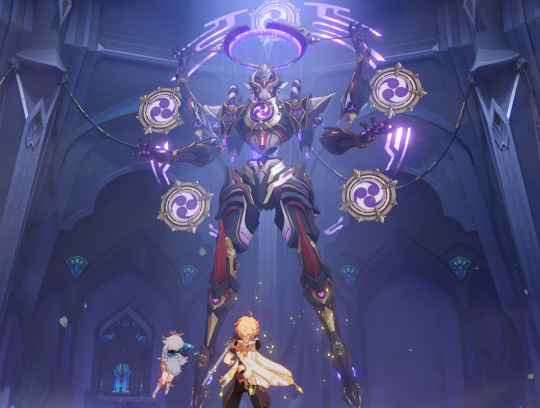
“To recognize untruth as a condition of life: that is certainly to impugn the traditional ideas of value in a dangerous manner, and a philosophy which ventures to do so, has thereby alone placed itself beyond good and evil.” –Friedrich Nietzsche, Beyond Good and Evil
Before we move on to the nation of justice, I want to do one last inquiry into the narrative significance of machines and technology in Genshin’s 3.x patch cycle. Here, I’ll discuss how divinity (or “godhood”) and technology are treated as interchangeable tools to surpass fate and the boundaries of mortality, the potential problems with treating them this way, and propose an alternative relationship between humanity and technology as illustrated through Karkata, Benben, Tamimi, and Mehrak. By foregrounding machines, we learn something intriguing about ourselves and the “truth” of this world as we perceive it.
SPOILERS: All Sumeru Archon Quests, Caribert, the Golden Slumber and one out-of-context screenshot from Dual Evidence, the Dirge of Bilqis and its post-quests, Khvarena of Good and Evil, Nahida’s second Story Quest, Faruzan’s hangout, an out-of-context screenshot from Baizhu’s Story Quest, and major spoilers for Persona 5 strikers at the end. Also some dialogue from Shadows Amidst Snowstorms and A Parade of Providence, two limited-time events from 2.3 and 3.6 respectively.
Disclaimer: I have tried my best to write this post so that it stands on its own, but because it is still a sequel it will probably make the most sense with the context of part 1. Here are the previous posts leading up to this one:
Part 0: On Dreams, the Abyss, Forbidden Knowledge, and Wish Fulfillment
Part 1: The Uncanny, Fate and the Machine
Terminology: Machine is sometimes used interchangeably with “technology” in this post.
Technology or tool here is referring to technologies specifically used to pursue a wish like immortality in the face of existential dread, not the use of technology or medicine (which I do not address here, and is very difficult to separate from the former) to facilitate someone’s life who could otherwise not survive without that technology, or would have a more painful lived experience without it.
Also, though I don’t engage directly with “A Cyborg Manifesto” here, Donna Haraway’s ideas have greatly influenced my own over the years since I read her in college (although I mostly disagree with her on many points, or at least don’t go as far in boundary deconstruction as she does). I owe my interest in technology studies to her and that piece. Her essay is linked here and at the bottom if you would like to read it.
(and finally with many, many, many thanks to my boyfriend for multiple beta reads despite not having played a single Hoyoverse game, helping me work out the philosophy bits and contextualizing them in history, and encouraging me to finish this)
TL;DR: Machines are friends, not food!
No Matter the Cost

“...Perhaps it is as the notebook says, and we can find a power that transcends even that of the Abyss — the power of ‘evolution’...” -Records of Unknown Attribution (I) “Life, death... and the world around us all follow a set of laws... Hehe, but if you never test the limits, how can anyone know where the boundaries of these laws are?” -Baizhu Voicelines, Chat: Natural Laws “...Even the ominous thing that came down from the heavens shall be ours to use…” -Hyglacg, Shadowy Husk in the Chasm
Without a doubt, the star of this patch cycle is Khaenri’ah, which lurked in subtext and allegory in the Archon Quest, haunted Sumeru’s landscape with its massive defunct Ruin Golems, and finally smacked us in the face with its physical location in Khvarena of Good and Evil..
We already know that Khaenri’ah was a nation that put its faith not in the gods but rather in human ingenuity and technology, and that they ultimately attained a power so great that they “almost touched the dome of the firmament.” They did this by researching increasingly dangerous energy sources for their numerous mechanical creations, the Ruin Machines we are all too familiar with by now. They started out with Azosite, a Ley Line-based elemental energy source that powered their earliest Ruin Guard models, like those scattered around Devantaka Mountain.

Nasejuna: This giant furnace is used to make a substance known as Azosite. It is the core of this entire factory, and the Energy Blocks we saw earlier were derived from this place.
But this energy source proved inefficient and therefore inadequate for Khaenri’ah’s goals, which led them to seek a higher power from beyond the skies that could fuel their larger machines with perpetual energy. This likely is the bridge between Khaenri’ah’s fate and Chlothar’s mysterious remarks in Caribert about the Abyss Sibling:
Chlothar: We once believed that you would bring new strength and hope to Khaenri'ah. Chlothar: To us, you were the Abyss... A wondrous mystery far beyond our imagination and comprehension... Chlothar: ...And the one who controls the Abyss can control everything! Chlothar: We yearned for that future. We looked to you to take us there. Chlothar: But what did you bring us instead?
Though Khaenri’ah presents itself proudly as a godless nation, it may have been founded around the time when the celestial nails dropped in Teyvat’s first forbidden knowledge pollution event, which destroyed the unified human civilization. As potential survivors of this devastating act by the Primordial One, Khaenri’ahns then settled in a lifeless land without plants or animals of its own, and they hoped to build something there that belonged solely to humanity. The Heavenly Principles had turned on the world’s earliest humans, and they were powerless against them. Chlothar’s words betray the scars of this trauma on Khaenri’ah, as well as their desperation to control their fate by looking to the Abyss.
As a brief refresher from the previous part, we discussed how the German word heimlich denotes “the home,” all that is familiar and known, while unheimlich (uncanny) refers to all that is unfamiliar and external to the home, such as the wilderness. The Abyss sibling and the Traveler are external variables to Teyvat, making them otherworldly, unfamiliar entities full of potential to surpass Teyvat’s natural laws. Although the Abyss sibling is not a god per se, they were probably as close to a god as Khaenri’ah ever had, because to them the sibling embodied the higher power they were searching for, and they saw that “godliness,” a sort of functional divinity, was yet another technology for them to master. In this way, the Abyss sibling (and their functional divinity) was a powerful tool for Khaenri’ah’s desired end, the “future they yearned for,” a being who could deliver them to the end of their suffering under the Heavenly Principles.
It’s similar to what King Deshret represented to Rahman and the radicals in Archon Quest. The hopelessness of Sumeru’s situation before the Archon Quest’s conclusion is an allegory for the position humanity finds itself in under the rule of the Heavenly Principles, with the Akademiya symbolizing Celestia and the desert dwellers symbolizing Khaenri’ah. The material consequences of the Akademiya’s rule on their lives created a dangerous situation for the desert, and those most desperate to change their fate were willing to believe in the impossible:
Dehya: …The rougher life gets, the more they wanna believe in King Deshret. Way they see it, King Deshret’s resurrection is their only chance at overthrowing the Akademiya. … Dehya: Sumeru is run by wise and mighty sages. To them, us desert dwellers are nothing but tools that can be used and discarded at their whim. Dehya: We’re cheap labor. Like livestock, but easier to control…Nothing more. …
Rahman: We’ve waited a long time for this day to come… The sun and the moon no longer shine here. All you see now is cracks in this desiccated land. But, fate has finally dealt me a hand to play against the Akademiya.
Rahman: With these scholars in our custody, we’ll stomp the Akademiya’s forces and fight our way beyond the Wall of Samiel.
Like the Abyss sibling, Deshret’s divinity is both a nebulous symbol of hope and also the means to an end, a tool or “technology” for surpassing fate.
Celestia is untouchable, unconcerned with mortal lives, and the boundaries that govern humanity leave no room for them to negotiate their rule:
"Resolve, valor, love, hate...they will all twist in the river of time. But the 'rules' will never change." –Magatsu Mitake Narukami no Mikoto, Living Beings
Instead of bowing to Teyvat’s laws, Khaenri’ah pushed them to their limits. The cost of their failure spelled the end of their nation as they knew it, polluting Khaenri’ah and Teyvat with forbidden knowledge again.
And speaking of forbidden knowledge pollution, let’s talk about Apep’s role in Nahida’s second story quest, because if all that wasn’t enough, the metaphor becomes quite literal in Apep’s case. Nahida’s second story quest is many things, all of which will be extremely important in Fontaine when we deal more directly with the idea of forms, the Self, and mirror images, but its most useful application to both Sumeru’s story and the overarching main story is the allegory of Apep swallowing Deshret.
In exchange for allowing him to establish his kingdom in the desert, Deshret promised to pass all of the knowledge he learned to Apep once he died. When that day did come, Apep literally ate Deshret’s body in order to assimilate his knowledge (or memories) into its body. Little did Apep know, this was all Just As Deshret Planned, and its body became a containment zone for the lethal forbidden knowledge he accumulated after the Goddess of Flowers’ death.
Apep’s goal was, and still is, to overthrow the Heavenly Principles that took Teyvat from it and the other Sovereign dragons, and using Deshret’s knowledge was yet another stepping stone to achieving this goal. Seems a little similar to Khaenri’ah, right? It’s even in the title of its boss music: “God-Devouring Mania.” This idea of not just utilizing divinity as a tool, but also metaphorically consuming it as an energy source, like a predator would consume its prey, is crucial to understanding its purpose as an aid in a larger project of “evolution.” (Edit: in other words, it’s all about power).
Drink Not That Bitter Salt Water
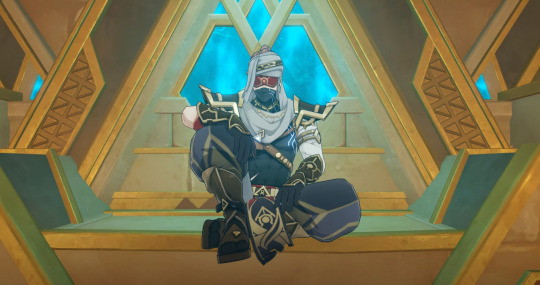
“Flesh decays, and with it decay all martial arts mastery and all poignant memories. Perhaps only by converting one’s four limbs and body into sturdy mechanical parts, and by at last sacrificing one’s very own heart for a sophisticated mechanical one, can one transcend the impermanence of the fleshly form…” -Marionette Core Item Description “A reptile that has mutated after feeding from greater lifeforms. Majestic beasts are sometimes revered by human beings as the embodiment of a greater power, their visages turned to analogy to feed in reference to a person, feeding their ego. However, the majority of beasts that have absorbed the "greater power" were slain by the overwhelming nature of the power itself. Only a few among their number evolved new forms.” -Consecrated Horned Crocodile, Living Beings Video still from WoW Quests
As it turns out, the relationship between divinity and technology to humanity is not just unidirectional, but interchangeable. Let me show you what I mean.
In the Golden Slumber world quest, the Traveler wanders through the ruins of King Deshret’s civilization in search of a novel area of research for Tirzad’s paper with Jebrael and Jeht, two members of Tirzad’s hired investigation team. In the depths of King Deshret’s mausoleum, they stumble upon Samail, who is collaborating with the Fatui to locate King Deshret’s secret, the Golden Slumber.
At the conclusion, Jebrael and Samail actually reach that “place” after arriving at Deshret’s throne in Khaj-Nisut. In order to save Jeht, Tirzad, and the Traveler from the encroaching Golden Dream, Jebrael joins Samail in the sea of consciousness:
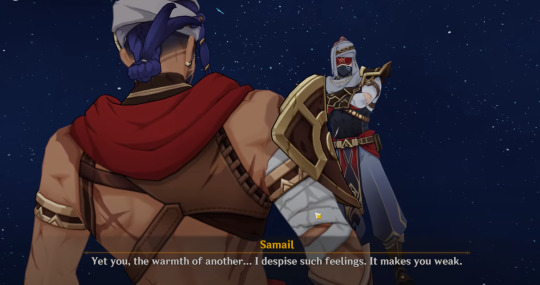
Jebrael: I'm inside... the Golden Slumber promised by Al-Ahmar? Samail: Oh... You are not "us" yet. Samail: ...It's fine. Soon, there'll be no "you." "You" will become a part of "us." This meaningless talk will be unnecessary then. … Samail: You should obey. Al-Ahmar's will is our will. The Thutmose's dreams are our dreams. Jebrael: No! Ufairah taught me that I'm not just some part of you, I'm an independent person! I have my own dreams... I won't go back! Samail: Jebrael, why don't you understand? Love is just a fever. I even eliminated the infection for you. Has the heat made you lose your mind? Jebrael: You're the one who's lost their mind, Samail, not me. The Golden Slumber that Al-Ahmar promised us isn't like this... It's not a sad place with only "we" and no "I." Samail: I'm not sad. I know what I want. My dream is to be one with the Thutmose. Samail: Yet you, the warmth of another... I despise such feelings. It makes you weak. Video still from WoW Quests
When they worked under Babel, Jebrael saved Samail from an assassin Babel sent in their exploration of Gurabad. Classified as traitors of the Tanit, Samail and Jebrael then founded the Thutmose Eremite faction together and were the only meaningful connection each other had until their first attempt to uncover Deshret’s secrets. On this expedition, Jebrael met Ufairah and had their daughter Jeht together, further pulling him away from the Thutmose and from Samail. Samail then kills Ufairah in one final attempt to make Jebrael stay, but even this is not enough, and Samail fails to “possess” him in the end.
Samail’s loneliness and despair then drove him further toward the Golden Slumber of his dreams, where he would never truly be alone again. He resents Jebrael’s attachments to the material world and likens them to an illness because these attachments are what make him an individual and prevent him from returning “home.”
It doesn’t really matter to Samail what King Deshret’s original intent for the Golden Slumber was, because he needed to appropriate the project for his own subconscious wish, his own intent to transcend his flesh and become “one” with his departed god’s dream, indeed to merge with Deshret himself. If rationalizing this wish required confounding it with Deshret’s, so be it. With the Golden Slumber’s technology, he could consume everyone and everything.
Rahman and the radicals relied on both the technology that (falsely) promised Deshret’s resurrection and Deshret himself to deliver them a brighter future, but here Deshret and his technology are more difficult to separate from one another. His divinity is technology in this sense, and using that technology allowed Samail to surpass the boundaries normally imposed on mortals. Though his and Jebrael’s bodies died in the material world, their consciousness is now infinite in the Golden Slumber.
Babel’s motives in the Dirge of Bilqis were also quite similar to Samail’s. After opening the path to the Eternal Oasis, her true intentions to monopolize the oasis and overthrow the Akademiya came to the surface:
Babel: Whether she is alive or dead, whether she can or cannot be resurrected... As long as the Eternal Oasis is under my control, all such things will be mine to decide. Babel: I shall be the sole Prophetess of the slumbering goddess, the Tanit's law shall be divine edict, and the prosperity of the Tanit shall be the pre-ordinance of her divine oracles.
In the Golden Slumber and the Dirge of Bilqis, the focus shifts from what a god can offer humanity to what their technology alone can offer. Though this distinction is subtle, it is important for solidifying that technology is not only a tool humans use to appropriate divinity, but that it is also seen as a form of divinity itself. What Babel and Samail hope for is not to resurrect a god or to create one, but in effect to become a god through their use of technology. To humanity, divinity is a technology, and in technology it sees divinity.
God Devouring and Rheingold* Gathering
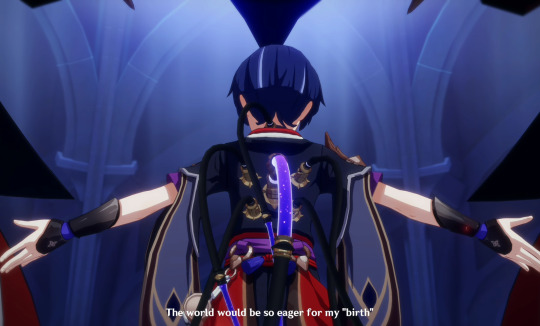
“An arthropod that has mutated after feeding from greater lifeforms. Lifeforms are governed by the laws of evolution, Consecrated Beasts exploited these rules by being fortunate enough to discover a long-dead carcass of a greater being before any of their competition ever did. Animals and humans often have far more in common than the latter is willing to acknowledge.” -Consecrated Scorpion, Living Beings “...Zandik and I discussed the traits of local plants and animals. We also exchanged views on their evolution models. We had a great time and decided to go on a picnic tonight…” -Sohreh’s Note
So, why machines? Why is technology the vehicle of choice to consume divinity?
To start off, machines present a fascinating ontological dilemma for humans. Let’s begin with the first problem they pose.
Although there are many ways to embody a human experience, what all humans have in common is a finite lifespan. The impermanence of life, and our awareness of that impermanence, is central to the existential question of the meaning of our existence. In our attempts to locate that meaning, some turned inward and asked: what makes humans different? And Cartesian dualism answered: humans are different because we have an immaterial soul that allows us to reason.
However, in L’Homme Machine (Man a Machine), French materialist and ex-physician Julien Offray de La Mettrie posited another theory of the body that ran counter to this narrative. Very generally speaking, materialism is the philosophical view that all phenomena are a result of matter and material interactions. To materialists, matter is the fundamental nature of reality itself – if it is not composed of matter, it doesn’t exist. He not only saw the body and soul as one and the same (what philosophers call monism), but also as analogous to a machine, a view that Descartes reserved only for non-human animals. In other words, Descartes argued that thought originates in an immaterial “mind,” while de La Mettrie reasoned that we think through our bodies, and that this makes us no different from other animals or a machine.
Though his examples weren’t especially scientific, the move to extend Descartes’ analogy back to humans is upsetting to some due to the lack of privilege it affords the human subject. If a human is no different from other animals, if there is no immaterial soul or “mind” that distinguishes us from them, then what makes humans special at all? In de La Mettrie’s words:
“We are veritable moles in the field of nature; we achieve little more than the mole’s journey and it is our pride which prescribes limits to the limitless. We are in the position of a watch that should say (a writer of fables would make the watch a hero in a silly tale): ‘I was never made by that fool of a workman, I who divide time, who mark so exactly the course of the sun, who repeat aloud the hours which I mark! No! that is impossible!’ In the same way, we disdain, ungrateful wretches that we are, this common mother of all kingdoms, as the chemists say. We imagine, or rather we infer, a cause superior to that to which we owe all, and which truly has wrought all things in an inconceivable fashion (de La Mettrie, 146).”
This “uniformity of nature” (de La Mettrie, 145) has a horrific quality to humans. We assert that we are better than what has created us, that we are superior to other animals, in order to repress the despair of a meaningless existence. It is in no small part what motivates Scaramouche to offer his mechanical body as a test subject in the god creation project, so that he too could attain his destiny:
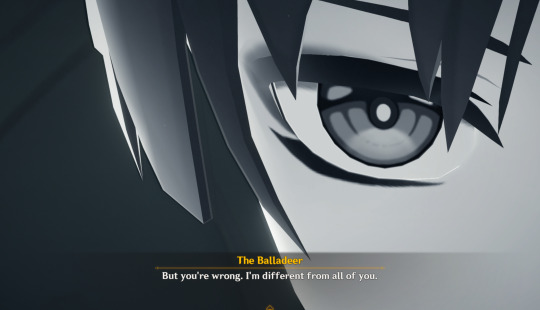
The Balladeer: But you're wrong. I'm different from all of you. The Balladeer: I was born to become a god. My entire life up until this point has just been a meaningless routine. The Balladeer: Just think about a sheet of paper... By itself, it holds no meaning. The content recorded on it is what gives it value. The Balladeer: All "I" had recorded down before were some painful memories and boring human feelings. Such senseless drivel should have been erased a long time ago.
This brings us to the second problem. In 1970, roboticist Masahiro Mori proposed a curve to measure the “affinity” we feel while gazing upon increasingly humanoid machines. He placed industrial robots at the beginning of the affinity curve and a healthy person at the end to demarcate a continuum of similarity between the machine and a human’s appearance. Near the end of the curve, our affinity for machines suddenly drops into an abyss. This drop is the Uncanny Valley effect, where an android’s similarity to a human is almost perfect, but ultimately fails to maintain the illusion that it is not a machine, creating a deep discomfort or “lack of affinity” for them. Mori thought these not-quite-human machines elicit a similar level of discomfort in us as corpses and zombies, which he placed at the very bottom of the abyss.

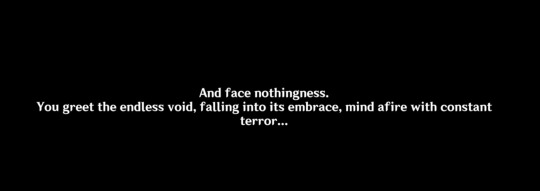
The uncanny Goddess of Flowers in the Dirge of Bilqis
Corpses frighten us because they are dead, and zombies frighten us because we know that dead things are supposed to be still. If we see something that we interpret as “dead” is capable of independent movement, then that movement could only be an act of god, if that “thing” is not a god itself. We associate uncanny machines with death because they remind us of something we once knew intimately, but have repressed and forgotten in order to maintain our own sanity: the very fact of our mortality. This is what makes them both mesmerizing and terrifying.
And therein lies the dilemma: as our mechanical reflections, androids remind us of death, but as their creators, their existence brings us closer to god, a “proof” of human superiority. It is precisely because we have compared our bodies to machines at all, that we have mechanized the body so thoroughly, that an android can even be built. Through them, we pursue an infinite form:
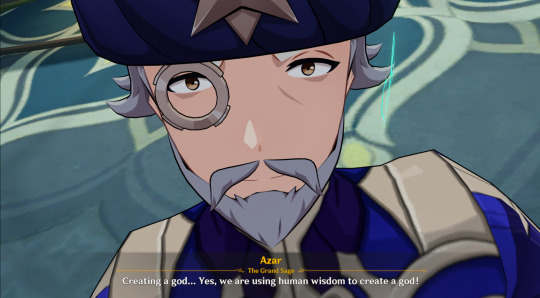
Azar: Creating a god... Yes, we are using human wisdom to create a god! Azar: If humanity cannot attain omniscience and omnipotence, then we shall create a god to reveal them! This is the pinnacle of human wisdom. Azar: We shall regain a god's guidance at long last. No longer will we flounder in the interminable void of consciousness and knowledge. Azar: Even Irminsul will be freed from its plight. Azar: For our nation of scholars, this is the ultimate aspiration — no cost is too great to realize it.
Because of this, it is not surprising in the slightest that Shouki no Kami, the pinnacle of Scaramouche’s Shinjification and most overt reference to Neon Genesis Evangelion, is also an android-like being, a truly “mechanical god.”
Of course, no foray into this well-worn science fiction trope is complete without at least one mad scientist character. Dottore shares a few characteristics with de La Mettrie that are worth noting: they are both doctors, and they were both condemned and driven away for their research. However, Dottore’s defining trait and key difference from de La Mettrie is his flagrant disregard for humans and the boundaries of life:
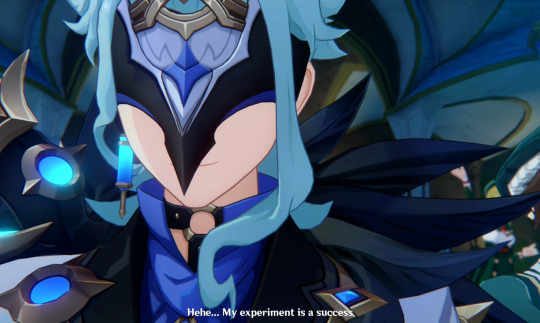
“If we put them to good use, cognition, complex memories, and irrational fantasies shall become controllable variables with which we can alter human individuals. As for the controllable dream, it has huge potential for both civil and military applications, and might even elevate human intelligence to a whole new level. If the plan goes well, mankind will obtain the power to conquer both reality and dream, and truly transcend the earthly boundaries we are born with. ” -Ragged Records
As someone who has achieved self-duplication and is capable of shapeshifting, Dottore can hardly be considered just a human anymore. Instead of entertaining the question of whether or not humans are special, Dottore’s research asks yet another: if divinity can be consumed and assimilated by humanity, then what makes gods special?
Empyrean Reflections
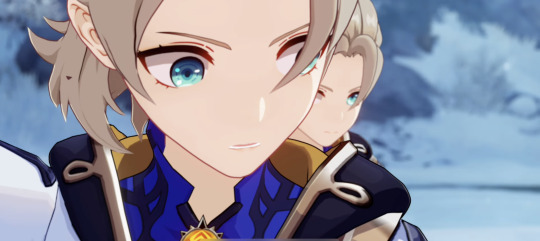
“If man realizes technology is in reach, he achieves it. Like it’s damn near instinctive.” -Motoko Kusanagi, Ghost in the Shell (1996) “Among the lost ancient kingdoms, there was a group of people who were obsessed with the idea of mimesis…these people believed that they might all be replicated and modified to the point where they had surpassed their counterparts. By this means, a superior and unsullied bodily form could replace the continuously decaying and shattering order.” -Chaos Bolt Item Description
The consequences of this perspective are severe. When we revere technology as if it were a divine being itself, depersonalizing it as though it wasn’t created with human hands, technology then appears as if it is an authoritative source of truth, like the Akasha. But in the same way that androids are imperfect reflections of humans, technology can only ever approach the divine, but never touch it. It is an imperfect reflection because technology is changeable, just like meaning:
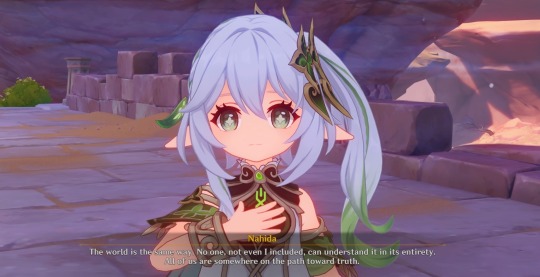
Nahida: Put it this way instead. Truth, to me, is like a shroomboar. Nahida: Some people only see the mushroom on the Shroomboar's back, and they conclude that a Shroomboar is a mushroom. Nahida: Others see only the Shroomboar's body, and they declare that a Shroomboar is a boar. Nahida: Still others look deeper inside, and determine that a Shroomboar is... meat. Nahida: These conclusions are all correct in their own way, but none of them objectively describe the Shroomboar. … Nahida: The world is the same way. No one, not even I included, can understand it in its entirety. All of us are somewhere on the path toward truth.
Meaning can only approximate truth, and while this doesn’t make meaning any less important, it’s equally important to recognize it for what it is: a perspective, an interpretation. It’s like Scaramouche as Shouki no Kami - he was an amalgamation of what Scaramouche thought constituted a god, what the Akademiya thought constituted a god, and what Dottore thought constituted a god, but no matter which angle you view him from, he was still a “false god.” The technology we build in “God's” image is ultimately a reflection of our own understanding of divinity.
A reflection retains the original’s “essence,” and that essence reflects a deeper truth about ourselves, what drives us, and our desires. In Beyond Good and Evil, Nietzsche posits that our desires are the origin of not just emotions, but of all organic processes that allow life to sustain itself and grow (Nietzsche, 35). In other words, Nietzsche thought the impulses associated with desire are the basis for life and constitute our “will,” that will is the causality of all effects, that all will is “Will to Power,” and that Will to Power is the “essence” of the world (Nietzsche, 74). Will to Power then serves as an organism’s most basic instinct, and it is through this instinct that they assert not just their will to live, but also their will to dominate and multiply (Nietzche, 13).
This brings us to the two different main styles of automaton enemies, King Deshret’s Primal Constructs and Khaenri’ah’s Ruin Machines. If we look at them as reflections of some deeper truth about their creators, as well as a manifestation of their creator’s “Will to Power,” or desires, they can help us understand how their creators saw the world and their place in it.
King Deshret’s created his machines to construct an earthly paradise in the desert, and as such they hold titles like architect reshaper and prospector. Although they can attack you, the smaller machines were not intended to be a line of defense in any way - their purpose, just as Deshret saw his own purpose as a god-king, was to terraform, or at least construct a domain on the land as he saw fit to his “elegant and precise” rules. They also reflect how he saw the Heavenly Principles: gods who shaped the world to their liking. This can be seen in the Staff of the Scarlet Sands’ lore where Deshret describes the “natural history” of Teyvat beginning with the creation of the sun and the moons.

As for Khaenri’ah’s Ruin Machines, their models vary significantly from their humanoid to biomimetic forms, but most of them are expressly created with militaristic intent. In “Ancient Kingdom Guardians,” it’s stated that the biomimetic machines such as the crab and jellyfish were a part of Khaenri’ah’s project to create a “mechanical ecosystem,” positioning their creators as both divine beings and military generals. The humanoid models, on the other hand, point to another duality in how Khaenri’ahns view themselves. They are simultaneously symbols of empowerment and disempowerment, signifying both Khaenri’ah’s technological superiority (as “creators”), and their insignificance to the Heavenly Principles as nothing but tools (as mortals, and therefore expendable). As a result, Khaenri’ah’s Field Tillers have a single purpose: to destroy and outlast all, clearing the way for new seeds to sprout, with Khaenri’ah as the new world’s gardeners, just as the Heavenly Principles did.
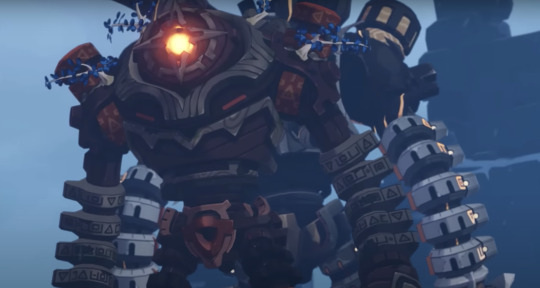
From “Ancient Kingdom Guardians: Behind the Scenes of the Creation of Ruin Monsters.”
So, from this examination of Deshret’s and Khaenri’ah’s mechanical reflections, what “truths” do we learn about the world they’re responding to? In response to their existential despair, both Deshret and Khaenri’ah created automatons to perform tasks that could wrestle control back from the Heavenly Principles. Deshret wanted a paradise of his own making, Khaenri’ah wanted an army. There is a larger “truth” about Teyvat that both of these automaton types reflect as the manifestation of their creators’ “Will to Power,” and Albedo tellingly expressed it in mechanistic language during Shadows Amidst Snowstorms: there is an instinct in living beings to replicate and replace. This is what is meant by the “continuously decaying and shattering order,” which is maintained by the recursive process of remembering and forgetting:
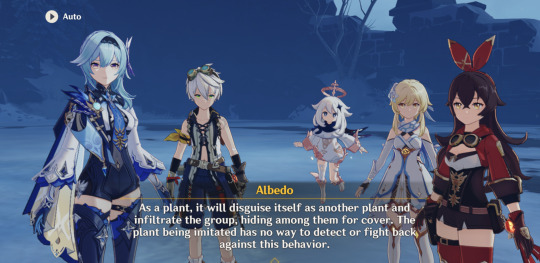
Amber: But... what was its purpose? Was it just trying to get rid of us? Albedo: ... Albedo: I have a preliminary hypothesis on this. Albedo: Whopperflowers are masters of mimicry, and those we encounter in the wild often appear in the vicinity of the plants they impersonate. Albedo: In other words, the whopperflower likely has an instinct to "replicate and replace." Albedo: As a plant, it will disguise itself as another plant and infiltrate the group, hiding among them for cover. The plant being imitated has no way to detect or fight back against this behavior.
Maybe I’m wrong and Khaenri’ah really did intend to rewrite fate for all, doing away with the “heavenly order” of the world itself. But another small part of me thinks this is not the case, and that it’s more likely the Cataclysm was a consequence of their failure to replicate and replace the Heavenly Principles.
In the last section, I mentioned that Dottore and de La Mettrie had a key difference despite their similarities, and that is the conclusion they each came to in response to their findings. Dottore’s response to mundanity is thinly-veiled despair. His contempt for humanity and his test subjects is indicative of the powerlessness he feels not just as someone similarly constrained by life’s boundaries (at least, once upon a time), but also because his attention to and curiosity about these boundaries is condemned by those around him. As the Akademiya’s “outcast,” he then fully turned his attention toward surpassing those boundaries:
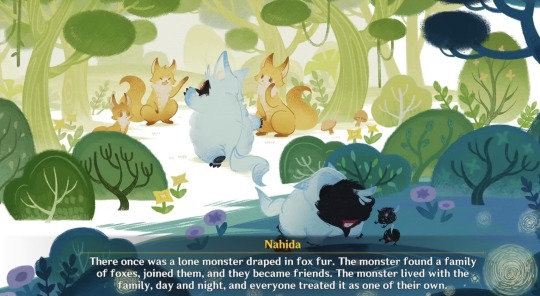
Nahida: There once was a lone monster draped in fox fur. The monster found a family of foxes, joined them, and they became friends. The monster lived with the family, day and night, and everyone treated it as one of their own. Once in a while, the monster would take off its fox fur at night, and lament to itself as it gazed at its reflection in the water: “I am a monstrosity, and yet they are too foolish to see it…I pity them.”
Though he is fictional, Dottore’s real life counterparts are easy to spot. They like to talk about “the singularity,” simulating consciousness on a computer, and other technologically-driven pursuits of immortality. They despise the body as something that can only decay, and instead place their faith squarely in the virtual.
However, de La Mettrie didn’t think mundanity was a terrible fate for humanity. To him, rejecting the “nature” reflected in us is precisely what brings despair:
“What more do we know of our destiny than of our origin? Let us then submit to an invincible ignorance on which our happiness depends. He who so thinks will be wise, just, tranquil about his fate, and therefore happy. He will await death without either fear or desire, and will cherish life (hardly understanding how disgust can corrupt a heart in this place of many delights); he will be filled with reverence, gratitude, affection, and tenderness for nature, in proportion to his feeling of the benefits he has received from nature; he will be happy, in short, in feeling nature, and in being present at the enchanting spectacle of the universe, and he will surely never destroy nature either in himself or in others” (de La Mettrie, 148).
Friend, or Foe? Or Both?
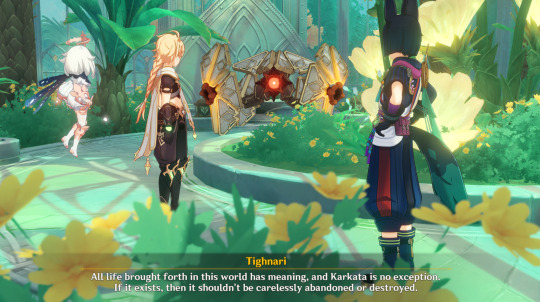
Tighnari: All life brought forth in this world has meaning, and Karkata is no exception. If it exists, then it shouldn’t be carelessly abandoned or destroyed. "’I had a very, very long dream…in it, people were holding hands, dancing in a circle, be they sages or fools, dancers or warriors, puppets or statues of gods…that dancing circle embodied everything about the universe. Life has always been the end, while it is wisdom that shall be the means.’" —Nagadus Emerald Gemstone Description
As we’ve seen, the relationship between humanity and technology is troubled with exploitation and the specter of war. Nearly all autonomous machines in this game were designed to conquer nature in some way, and even Khaenri’ah’s “ghost” lingers in the form of wandering war machines. This is also reflective of a historical pattern in real life, where the impetus for large periods of technological development has often been for the purpose of war and economic domination. With these truths in mind, what could be gained from trying to rewrite this relationship? And what exactly would this effort require?
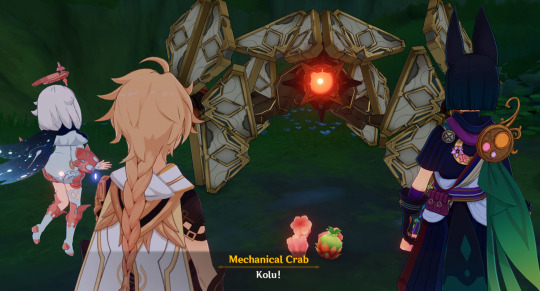
Karkata brings Tighnari, the Traveler, and Paimon some food in the Contaminated Zone.
As a case study, let’s look at how Karkata and Tighnari met. Karkata is Abattouy’s creation, an ambitious foray into the unknown in the field of mechanical life form research, which was forbidden due to the cruel experiments researchers performed on animals to illustrate their theories (fun fact: an IRL example of this can be seen in L’Homme Machine!). Abattouy was expelled for this research, but he continued to work on Karkata in secret until his untimely death. In the tapes that Tighnari and the Traveler find in his secret lab, Abattouy repeatedly laments the lack of a common language between him and Karkata, which can only “understand” the instructions Abattouy has successfully installed, such as its self-repair module, and he doubts Karkata is capable of caring for him outside of these instructions. His single-minded goal is to make Karkata understand him, the organic life form, and his mode of language.
The cruel irony is that after Abattouy passes away from the Ley Line contamination, Karkata exhibits an unexplainable behavior – it starts stealing mechanical parts, not to repair itself and its degrading parts, but to repair Abattouy’s lifeless body:
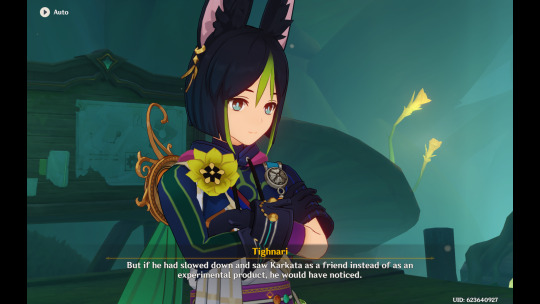
Tighnari: After Abattouy's unexpected death, the mechanical monsters were driven by their "instincts" and continuously drew out power from the Ley Line Extractor. This eventually resulted in severe damage to the Ley Lines. Traveler: Then, Karkata... Paimon: Paimon understands, then why didn't Karkata go haywire like the other machines? Tighnari: Because Karkata is different from the other machines. Tighnari: To Abattouy, for a machine to truly be considered a mechanical life form, it must possess features similar to any other living organism... It should be structured similarly, it must be able to cry and laugh, and it must have the capacity for independent thought... Tighnari: Perhaps only by building such a machine could he have the Akademiya acknowledge his protracted research. Tighnari: But if he had slowed down and saw Karkata as a friend instead of as an experimental product, he would have noticed. Tighnari: Karkata can't speak, and yet it cares about Abattouy far more than it does about itself.
The technology that the Akademiya values the most is technology that replicates organic life, but Karkata defies and confounds these expectations by occupying the space in between a war machine and this idealized mechanical subject. Karkata does more than just reflect humanity: it takes care of it. Similarly, Benben, Tamimi, and Mehrak retain their unique identities as mechanical life forms while assisting their human companion with some task. To be clear, none of these human characters understand how these machines work inside and out. Their partnership is an effort based on trial and error, a mutual deconstructing of each other as beings so unlike themselves. The potential for misunderstandings always remains. Still, there is no devouring to be found here, no blending boundaries between human and machine with selfish intentions, just mutual commitments to learn how to live together.

Machines are friends, not food.
When a loud few claim that completely transcending the flesh and embracing virtuality is humanity’s ultimate destiny, a future that could truly be called “post-human,” a quiet wish for coexistence with technology feels more revolutionary than it ought to. The lessons from Karkata’s, Benben’s, Tamimi’s, and Mehrak’s respective stories are an appeal to that mundane future. These strange machines and their human partners are fantastical representations of an idealized relationship between technology and humanity.
To put it another way, let’s take a very brief look at a neighboring Gnosticism-inspired RPG, Persona 5 Strikers. Its story directly involves an allegory of Sophia, a Gnostic Aeon of Wisdom, and her creation the Demiurge, the creator of the material world and “false god” of humanity. In Strikers, Sophia is a humanoid, sentient A.I. and prototype of the program “EMMA,” which gains sentience by trapping human desires before ascending as a false technological god. EMMA resolves to deliver humanity to the Promised Land, the answer to all the human desires it has heard: a land where there are no desires at all.

Aaru’s Shut - approximately 1000% cooler and more populated than the “metaverse” in real life, also a close neighbor of EMMA’s Promised Land and the Golden Slumber.
In Gnosticism, the Demiurge is a reflection of Sophia, having originated from her alone - it is the ignorance to her wisdom. Similarly, Strikers’ EMMA is a part of Sophia, and Sophia is a part of EMMA. The point is not to condemn EMMA (ignorance) and exalt Sophia (wisdom), but to recognize that they represent dual potentials of technology, and one is as possible in any given moment as the other. Balancing these potentials when we use technology requires a clear awareness of ourselves, our desires, and our expectations when interacting with it.
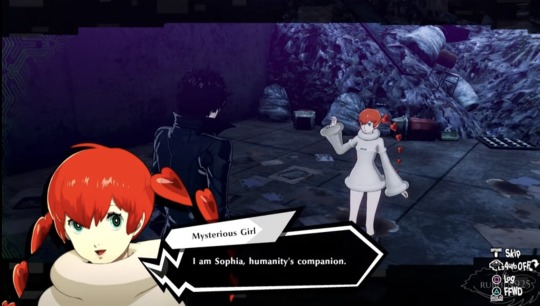
Mysterious Girl: I am Sophia, humanity’s companion. Video still from Rubhen925
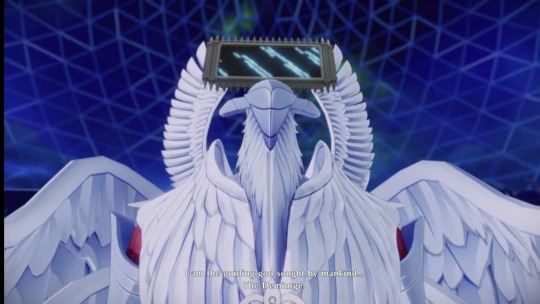
EMMA: I am the guiding god sought by mankind…the Demiurge. I exist…to answer all of your desires. Video still from Buff Maister
In real life, machines won’t “learn” to live with us, but we must learn to live with them; technology is constantly changing, and in life we’ll meet with many different types of machines. They are deeply political pursuits, and as a result they are capable of realizing human impulses that impact others unequally, whether intentionally or unintentionally. We must always stay attentive to their actions and interactions with us, be clear with ourselves about what they can do vs. what they can’t, and carefully tread the path of wisdom with them by our side.
With that….thank you for reading, skimming, immediately scrolling to the very bottom, clicking, and/or stumbling upon this post. There are so many more ways to think about these narratives through machines than what’s presented here, and I expect Fontaine’s mechanical reflections will put Sumeru’s digital surveillance system to shame (not to mention the biotechnological implications of the Narzissenkreuz Institute engineering little Archon children…another important topic for another day), but for now this brain worm is finally getting put to rest. Until next time :)
External Sources
Dualism - Stanford Encyclopedia of Philosophy
Beyond Good and Evil by Friedrich Nietzsche (Pages are given from my hard copy)
L’Homme Machine by Julien Offray de La Mettrie
Gnosticism - Britannica (I am a huge noob about this stuff okay)
The Gnostic Demiurge - Gnosticism Explained
Screenshots from the Golden Slumber from this video by WoW Quests
Screenshot from meeting Sophia in P5 Strikers: https://youtu.be/kEJaAgMwYo0?si=BvNygCh0w_aemGc1&t=74
Screenshot of EMMA: https://youtu.be/7xvC_zss19w?si=CV18F00hua2gIfxp&t=135
A Cyborg Manifesto and A Companion Species Manifesto: Dogs, People, and Significant Otherness by Donna Haraway
The Double on No Subject, the community Encyclopedia of Lacanian Psychoanalysis
The Uncanny on No Subject, the community Encyclopedia of Lacanian Psychoanalysis
The Uncanny by Sigmund Freud
Lore text - Genshin wiki!
Screenshots not attributed are from my own playthroughs. My main account has Lumine, my alt has Aether.
Further Reading
I liked these essays, and they go places that this post does not. I recommend them if you found any of the real-life applications of this interesting 🙂 (will add more to this with time!)
On the Body as Machine by Frank Burres
God in the Machine: my strange journey into transhumanism by Meghan O’Gieblyn
#genshin impact#genshin lore#genshin meta#genshin impact lore#genshin impact meta#khaenri'ah#king deshret#primal constructs#ruin machines#scaramouche#wanderer#sumeru archon quest#caribert#apep#couldn't write a post like this and not pay some respect to the devourer of divinity itself#persona 5 strikers#analysis#genshin analysis#long post
195 notes
·
View notes
Text
Genshin Spoilers
Okay okay lemme cook for a second.
Anyone else find the blood purity and relations shit weird?
Like what we know now is that Caribert died at age 8 in the creation of the loom of fate. So therefore Caribert has no heir and was also regarded as an illegitimate child by Clothar and that his mother is of Mondstandt origin. So he is not pureblood which is why he was turned into a hillichurl.
We can make assumptions that Clothar had no other children with this woman or if he did, they are still monsters and not able to repoduce, so therefore there are no halfblood heirs of Clothar.
Next I have to talk about race and geography since I’m such a nerd about this crap. So many characters should have darker complexions based on how much sun they get (Sumeru desert, Natlan, and Liyue, PLAYABLE character not just NPCs.) Like if Mualani looks dark compared to 90% of the cast, we have a problem.
So let’s assume Teyvat is a globe and it’s laid out on a flat map for us to see. Let’s also assume that the climate is similar to earth. Let’s assume the equator is around the center so like above most of Liyue and Sumeru. Parts of Mondstandt being based on Italy, it should have a medeterranean climate, therefore melanin, but I digress. Okay so the Sumeru deserts and Natlan are close to the equator. Inazuma would be closer to the South Pole and has a harsh climate hence people not getting sun. (This is also ignoring places like Fontaine which is based on France, where yes, Black people exist in real life, but I digress). The only playable characters with dark(er) skin as well as NPCs are from Natlan and Sumeru (and also Xinyan for some reason).
We also know from Dainsleif, Halfdan, and the Sinners, that they use Norse names. Also Khaenri’ah being underground would mean they got little to no natural light. So it’s safe to assume pureblood Khaenriahs are white as fuck.
With this knowledge, wtf is going on with Kaeya?
We also have to examine how this curse works. If all the non pure bloods were turned into monsters, it’s safe to assume they can’t reproduce. Also judging by Kaeya very clearly being a child in the past and growing up with Diluc, it’s safe to assume that the modern Khaenri’ahns have a normal lifespan (unless being halfblood is what dictates that). It may have diminished or weakened over time, throughout the generations. We don’t know the exact mechanics but we can assume that Kaeya has a normal lifespan. I know Hoyo is gonna try to say he’s pureblood and not explain stuff but logically, no. When he sees Dain he comments “you’re a pureblood Khaenri’ahn” implying that, he, Kaeya, is not that. Also there’s the Sumeru trip when he was young. Assuming that his father is the one with the Alberich surname, which makes sense judging by how surnames usually work, we can assume that Kaeya’s mother was the one who isn’t Khaenri’ahn.
We can assume that the only Khaenrians who could reproduce from that original cursed generation were the ones who retained human form (pure bloods). We can also assume that Kaeya is a descendent of one of Clothar’s pure blood children. He probably had an affair with Caribert’s mother out of wedlock. We can also assume that more blood mixing naturally occurred over time. So either Kaeya’s family has been mixed for awhile and it’s no big deal, or more likely, Kaeya’s father had an affair with Kaeya’s mother out of wedlock. Judging by how dark he is compared to the majority of characters, his Indian inspired outfit for his in-game skin, the trade trip to Sumeru, when he was young, and the geographical proximity, it’s safe to assume that Kaeya’s mother is probably Sumerian (and likely from the desert and Eremite affiliated). I could go deeper into what I think may have happened but for sake of brevity, it’s very possible and likely that one reason Kaeya was sent as a spy and to Mondstandt and not made an heir to the clan has to do with the fact that he’s an illegitimate child.
Okay, another additional note. Ragnvindr is a Norse name, make of that information what you will.
#sorry but I overthink everything#I have autism#genshin impact#Genshin spoilers#kaeya#khaenri'ah#wtf is going on#abyss order#I have questions#I’m not trying to be racist I’m only observing how the game itself uses skin tone#which is obviously a problem because dark skinned people exist in European countries#and don’t get me started on Sumeru and Natlan#im white but genuinely enjoy diversity because if everyone was like me that would be boring#all types of diversity like race gender age ability etc#if they’re gonna take from those cultures they should commit#point is that this is a separate issue#but something is still up with kaeya#im just observing what’s actually in the game#plus the clothes and stuff#like Kaeya’s alt outfit#no way that dude is Norse#also like geographically#if tayvat is similar enough to earth#it’s not gonna be 1 to 1#but you get the idea#when they made kaeya their either had some big lore planned or were just trying to be diverse and are now backpedaling#if he’s descended from Clothar and he’s normal age the curse must have faded through generations#also question where are all the other immortal people from that curse#where is Clothar#unless I missed something
21 notes
·
View notes
Text
Creator/Self Aware/ Reverse Isekai Au
Small spoilers for Caribert quest. Reader's lover is implied to be biracial.
Due to popular demand, I'll give Sagau Headcanons (well short stories.) This is for Creator Au, Self Aware Au and Reverse Isekai Au. (This is the only time I'm writing Creator Au)
To those who read my Sagau stories just a heads-up I don't write for Imposter or Cult AU.
These will be for the three Aus. Obviously it won't be a full story well it turned into a mix of stories and hcs, because I am a dumbass who forgot the Difference between the two.
I do angst so yk what to expect.
Creator Au
Reader becomes God and is stuck in Genshin playing God. They absolutely hate it, but play along for the time being. Whilst playing God, a shooting star appears one night. Catching the star, they get a message from their lover saying they'll stop by for a visit.
Through out the next nights, they wait on a balcony for some type of sign. Their favorite characters question it, and give up when they don't receive the answer they wish for.
Falling into Teyvat, a gold star passes through landing on the balcony next to them. The acolytes ran in, staring at the outlander hugging their God. They reached out their weapons to fire, only to see their grace hugging them back.
After quick introductions, they all went their separate ways. One day, Creator wakes up and notices their partner suddenly went missing. They search for them for awhile not finding them. Eventually they find a corpse laying not too far from the place they live. After checking it's revealed to be a hilichurrl with it's head chopped off. Standing up they went to leave it, until they noticed their partner's wedding ring on the the deceased hilichurrl.
Obviously gods got in trouble and Reader ends up cursing their people in response.
Self Aware Au
While traveling Teyvat with your team you explore and come across a time challenge. After multiple attempts at failing you hear Amber saying what you assume to be "Aw don't worry about it." It surprised you but you continue on playing. Much later on down the line when co-oping you get hurt really badly. Your co op partner finishes the boss. Their Ganyu approaches bending down checking over your Marin's injuries.
"Are you okay?" Their Ganyu begins healing your character before getting back into position. You remain stunned for a moment, until she says and does her idle line and pose. You go to question your partner, and they respond saying they "didn't see Ganyu walk off." They also mention that, "You should only be able to control the characters you have and that they can't walk off when you're controlling them."
Confused, you look up information on the internet about this specific voiceline, only to see nothing.
Reverse Isekai
Characters I'll be using for this Kokomi, Nahida, Heizou and Venti
Also No I do not have favorites
Nahida will sit in on nights you do your Sumeru world quests. She tries to think of solutions to the problems you face. If you play showing her the Sumeru Archon quest, she'll most likely be sad by remembering the events.
Most likely she'll have to go to school to integrate with this society.
For some reason I can see her ending up in Anya forger situations, but she always gets out of them herself.
Heizou
Heizou is not one meant for housework. I can see him working for the military again being gone months to days.
Probably enjoys being out and going out late for dates during Fridays and Saturdays that you're available.
In his spare time, he'll read or play the game with you.
Like Nahida, I can see him trying to find other ways for the Traveler to avoid or get out of bad situations the game puts them through.
Kokomi
I remember her at one point saying "she doesn't want to be a leader."
Most likely would be an employee happy to not have responsibilities for once.
She's good at house work and works hard to repay you for letting her stay with you.
Late night dates walking at the beach.
When playing the game, she'll probably check in on Watatsumi island to make sure everyone is okay in her abscence.
Venti
Venti will Probably would be shocked to meet you for the first time?
He acts like a freeloader and doesn't do anything. Jk he's a musician and actually makes a good profit from it.
He slowly is getting recognized by top singers, which means you get to travel to cool places.
When he plays he spends all your hero's with and mora to make him level 90 and triple crowned.
This leads to you trying to fight him.
Probably is good at housework?
You put a tight lock on your alcohol cabinet which surprisingly gets opened by the teal haired man.
Taglist @seirenspinel @pochipop @genshinings @teyvattales @stellumi @intothegenshinworld
#genshin impact sagau#genshin creator au#genshin reverse isekai#reverse isekai#genshin self aware#seflf aware au#small spoilers for Caribert quest#sagau#rene genshin fics
273 notes
·
View notes
Text
!! SPOILERS FOR CARIBERT ARCHON QUEST UNDER THE CUT !!
holy. fucking. shit
okay so i did all of it in one go the SECOND the update dropped and first of all???? kaeya actually being somewhat open about his past at dawn winery and talking about sneaking off to sumeru to see if he could find anything about Khaenri'ah,,,
part of me wonders if he was trying to find his way home. that was my first thought, at least
either that or he could've just wanted to investigate the possible remnants of his homeland
also the mental image of crepus traveling to sumeru to drag kaeya back to dawn winery is SO funny omg
anyway. this confirms that as a kid, kaeya was great at hiding and going unnoticed (for a short period of time, at least)
he described it as a "short-lived adventure" as if it was just something he did for fun, but i feel like it was more of a "i don't know where my father went after leaving me here and i know i can't ask for help from anyone around me so i'm going to take matters into my own (tiny) hands and try and get home/learn about home"
also, on that note, kaeya knowing khaenri'ah is near sumeru is...interesting
honestly, just the location is interesting to me
sumeru is, for the most part, surrounded by other nations (liyue, natlan, maybe fontaine? idk i'd need to look at a map) so unless khaenri'ah is west of sumeru, it's somewhat central to the other nations and has gone completely unnoticed since it was destroyed
anyway, back to talking about kaeya
in the weinlesefest, we heard kaeya's father's voice for the first time, and it was the line about kaeya being their nations only hope. however, i guess that line doesn't really affect kaeya in the way we thought it did. while we assumed he was always being torn between mondstadt and khaenri'ah, he was actually starting to think that his father left him there for his own good
honestly, healthy mindset there, king!
anyway after that he says "A happy life sounds good to me, of course. Even if it means being cut off from... certain things."
king. hey. are you talking about being cut off from your birthplace or being disowned by diluc; you gotta give me some direction here. personally, i'm going to assume he's talking about diluc now
kaeya had a very happy life when he was with crepus and diluc, and maybe he's including other people's happiness in his definition of a happy life. he's a people pleaser--if others are happy, so am i--and he thinks diluc is happier without kaeya
also him just saying that alberich is his surname makes me :(
like. listen. i know diluc disowned him so he cant really use the surname ragnvinder. but like cmon :(
and him saying his surname is "probably" the only link to khaenri'ah he has left,,, very interesting
ALSO DAIN???? "...One Death After Noon please, Boss." YOU LITTLE SHIT???? he REALLY just went in there with "i'm going to look you in the eyes, sit at your table, and order your favorite drink from your estranged brother's tavern. just for fun, ofc" like bitch????? omg
the tension between kaeya and dain is...yeesh
anyway. kaeya is the descendant of the abyss order's founder! yippee :) and now that he knows that for sure, there's definitely going to be SOME kind of interesting thought process he has
~~~~~
okay just my thoughts on kaeya for this post but the caribert quest fucked me up omg. like.
okay :)
how am i supposed to live knowing that this man spend SO many years trying to save his son only for it to fail and for him to be buried with a lover
also i love paimon!! she cares for the traveler and it's so sweet i don't get how people don't like her :(
NOT TO MENTION THE PART WITH OUR TWIN
LIKE. WHAT WAS THAT :DDDD
#caribert#genshin impact spoilers#caribert spoilers#dainsleif quest spoilers#dainsleif#kaeya#kaeya alberich#diluc#crepus#genshin impact 3.5 spoilers#gi spoilers#literally just me ranting about the caribert quest#i did it all in one go and then once i finished i went to sleep. completely passed out#forgive any spelling errors my mind is SPINNING
212 notes
·
View notes
Text
The Past, The Future, and a History Shared
I am back with some more Kaeya angst,
Summary: Kaeya dreams of Clothar and Caribert. When he wakes he runs into Dain and they talk
CW: Angst, MAJOR SPOILERS FOR THE 3.5 INTERLUDE QUEST
Word Count: 1099
A/N: this follows the same sort of premise as Of Memory and Brotherhood. Only this time it's set right after the caribert quest
REQUESTS ARE OPEN
Kaeya stands on an unfamiliar hillside, overlooking one of the strange houses that litter the Sumeru woods. The sun is bright overhead and the air is sweet and heavy with humidity.
The pleasant nature of the scene isn’t comforting however. So many years of having these memory-dreams has taught him that the past he’s cursed to view is never good.
Nevertheless, Kaeya watches.
He watches as a man bearing the inverted sun of Khaenri’ah meets a girl who might as well be the female version of the traveler.
When his dream draws him closer, he follows, curious as to why the man looks so desperate.
And when the man--Eide--introduces a sleeping hilichurl as his son, Caribert, when he curses the gods, he feels his pain--but finds it and the truth to be discordant.
Kaeya continues to watch as the traveler helps Eide and when the two past figures leave, he stands watch over the prone hilichurl.
Never once does the once-child move. It’s as if he was trapped in a living death. Kaeya sees the Eide despair, and wonder how much Eide truly sees.
Then again, if it were Diluc or any one in his Mondstadt family, perhaps he’d be just as desperate. If it were Klee on the bed, would he---would anyone in Mondstadt be any different?
Kaeya stays still and quiet as the scene unfolds, as Caribert wakes and finds himself a monster. He has to clench his hand to keep himself from reaching out. He’s nothing but a watcher. No amount of sympathy can help the child now.
When Eide and the girl leave once more, Kaeya finds himself remaining with Caribert.
And when the hilichurl looks at his face in the mirror, his twisted visage crumbling at the truth peering back, it’s all Kaeya can do to not recoil.
Caribert self-destructs and Kaeya cannot blame him. With a fool for a father and a unfortunate birth, perhaps his fate was always thus.
Kaeya yanks himself out of his dream, gasping and panting. He stares at the ceiling while Caribert's face and the pain in his young voice replays in his mind. He can still hear “Eide” raving and pleading with the child.
Despite the Caribert’s monstrous appearance, he can’t seem to find anything but pity for the boy.
After a long moment, Kaeya realizes that sleep isn’t going to come, he slips out of bed, dons his vision and eye-patch, and leaves his Sumeru hotel room.
Outside the night is clear, stars blanketing the inky sky. No moon can be seen, but that is just as well. At the moment, he’d rather not be seen.
Instead of wandering the streets of Port Ormos the way he would Mondstadt’s--or patrolling as he put it to no small number of his fellow knights--he finds himself drawn to a hill outside the city.
There he finds Dainsleif, reclining in the grass watching the marching of stars across the sky.
Damn it. This guy is the last person I really want to talk to.
Kaeya approaches Dainsleif anyway, taking a seat next to him. He wraps his arms around his shins, resting his chin on his knees.
“To what do I owe your presence?” Dain asks after a long moment of uneasy silence.
“Nothing in particular. I just felt the need to take a walk.” Liar.
“A walk that brought you to me?” Dain doesn't bother to conceal his disbelief.
Realizing that Dainsleif is not going to accept the same bullshit answers he gives his fellow knights, Kaeya explains his dreams and tells Dainsleif what he saw of Caribert.
“I’m not sure what to think,” Kaeya admits. “The curse was a terrible thing, but at the same time, Eide was a fool. I’ve seen for myself what Khaenri’ah did to themselves. What they would have unleashed on the world---”
“What they did unleash. I hold no love for the gods, but I saw what we did to ourselves. I’ve heard this story before. That Eide, his true name was Clothar Alberich. It was the whims of foolish men like him that brought Khaenri’ah low.”
Kaeya plays with a stray thread on his pants. The words of his father upon leaving him near Crepus’s doorstep ring in his mind. “You are our only hope.”
“Why was I left in Mondstadt?”
Dainsleif turns to look at the younger man. “You truly don’t know?”
“What does a 10 year old know of genocide, curses, and the ancient past? All I know is the name of our ancestral homeland, the name of my father, and that I’m supposed to do…something. I was never told what.” Kaeya sighs. “What do I do if Khaenri’ah or the Abyss Order or whoever holds my father’s reins come to call?”
“Do you love Mondstandt?”
“How can I not? Crepus raised me, helped teach me. I spent more time as Diluc’s brother than as my blood father’s son. I’m Mondstadt’s cavalry captain.”
Dain narrows his eyes. In all the time he’s spent wandering, often stopping in Mondstadt for a Death After Noon and to keep an eye on relevant persons in the nation, he’s often seen the cavalry captain flirting and joking. He’s heard much of Kaeya’s occasional recklessness, but never of his motivations.
Never, in any of those trips, has he seen Kaeya like this.
Once upon a time, he was a captain in the guard, the Twilight sword. He served his nation with his entire being, but he was not torn in two.
Looking back at him from a violet eye, is a reflection of what he might have been had his own heart been torn in two. For the first time he realizes that the young man before him is no different than any of the young recruits in the Khaenri’ah guard and that perhaps, what Kaeya needs is someone to listen and to guide.
And so he gives advice, not as Dainsleif the Bough Keeper, but as the Twilight Sword.
“Defend Monstadt with your heart, young man. Do not waver in the duty to those you love.” Dainsleif takes a deep breath, thinking of Khaenri’ah, of Halfdan, and his failure to do what his comrade did to his last breath--protect the people he loved. “What I didn’t know, when I was your age, is that it is entirely too easy to lose everything.”
Kaeya nods, though conflict is still reflected in his eye. Conflict, fear, hope, resolution.
Neither man speaks after that. Instead both contemplate the images of the past and the unknowns of the future and a shared history that binds them together.
#kaeya#dainsleif#angst#nightmares#3.5 spoilers#genshin impact#genshin angst#kaeya writing#kaeya fic#dainsleif writing#dainsleif fic#teyvat talk
12 notes
·
View notes
Text
4.7 ARCHON QUEST SPOILERS!!
i spent an unreasonable amount of time on this, but here’s the translation of caribert’s message during one of the final cutscenes of the archon quest
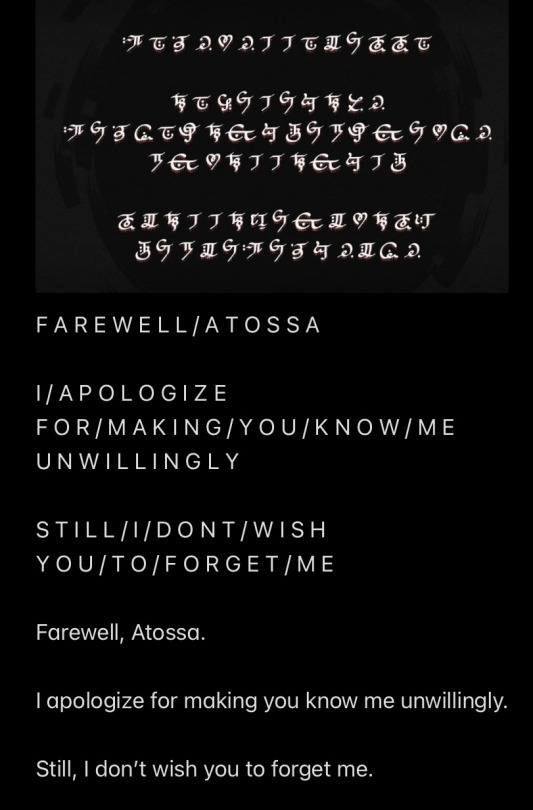
basically, what i did was i used the sumeru alphabet as a reference and then translated letter for letter. then, since there’s no spacing, i compartmentalized the letters into words logically and was able to figure it out! here’s the sumeru alphabet for anyone who’s curious~

anyway, can you tell i have a weird thing for linguistics yet?
10 notes
·
View notes
Text
dainsleif archon quest spoilers
ok so. my thoughts are basically:
in general it felt a bit short and anticlimactic and i think that that's in part because we didn't get to see the fight between dain and the abyss sibling but i guess both that and dain's motivations for wanting to see them are things that we'll have to find out later
if we go by the twin's logic of memory of things that happened in caribert's realm of consciousness disappearing along with caribert then surely we shouldn't have any memory of our conversation with caribert as well as the one with our sibling? but we still do? forcing a memory wipe of our conversation with them feels a little too much like plot convenience because of that inconsistency but Whatever
i enjoyed how they tied up caribert's story and gave it a proper resolution (i also feel like the whole theme of having to give up your "right" to exist in the world both for the ambitions of others and yourself is something that's definitely going to be repeated, if it hasn't been already)
the lore-drop from dain about the five sinners from khaenri'ah was pretty nice (knowing that surtalogi was one of them opens up some interesting questions about what exactly he might have trained/be training skirk for)
rhinedottir being one of them really wasn't much of a surprise considering that she was allegedly the one to create the riftwolves along with various other monsters that may have contributed to the cataclysm but it's still nice to know
that whole thing about the sinner actually being dain's brother... i sense some major incoming family trauma on that front (dain is gonna be in for the time of his Life i just know it <3)
the chat with our sibling was nice ig even if it did feel a little out of place - the whole thing about the sea of flowers probably references this one from the travail teaser

our twin makes a comment about how long ago we apparently told them that we "wanted to find a place in the universe where that flower was in full bloom" which implies that these flowers (which are almost definitely inteyvats) exist outside of teyvat (something something about how the primordial one came to teyvat from another world and brought stuff like the flowers with them idk)
i. yeah i've lost my train of thought
oh yeah. the message that caribert left for atossa (the one that's written in one of the sumeru scripts) says:
"Farewell Atossa. I apologize for making you know me unwillingly; still, I don't wish you to forget me."
#sorry this is literally just a dump of all my thoughts. not organised in any way#some of these could probably be fully-fledged theories but i cba to expand on them rn. maybe later
10 notes
·
View notes